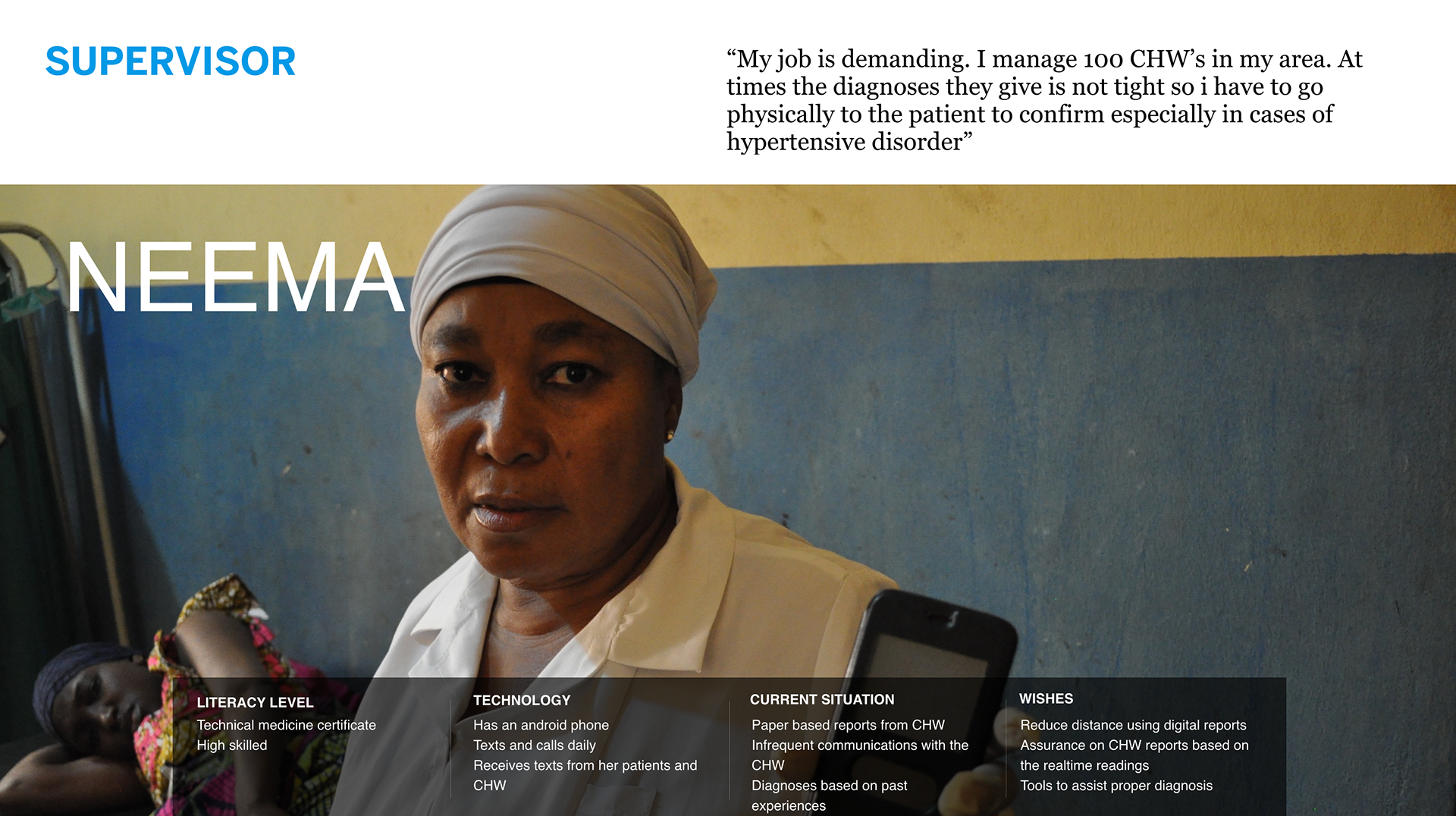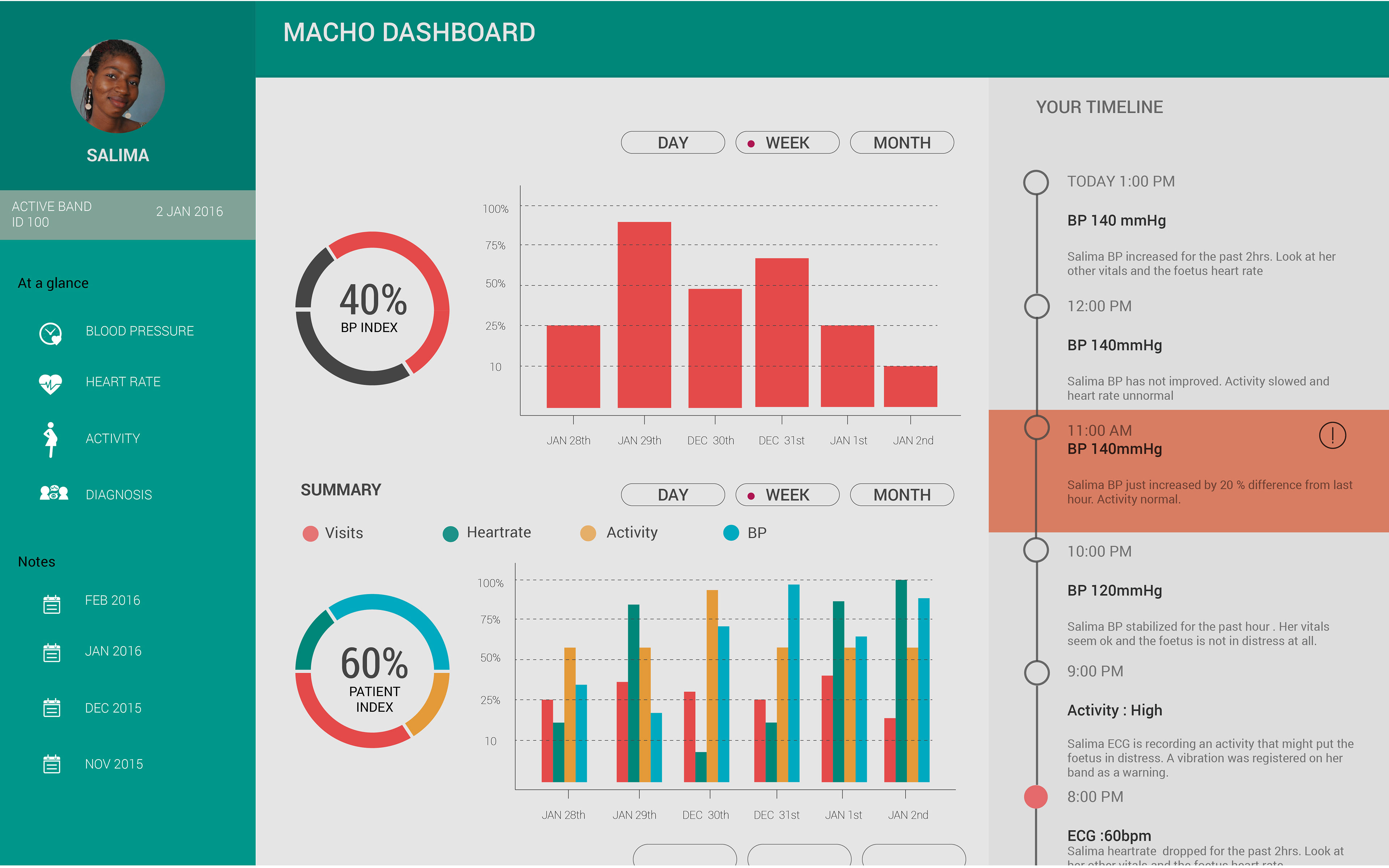BIG QUESTION
How does wearable technology helps reduce maternal mortality during childbirth in Kenya?
Maternal mortality is unacceptably high. About 303,000 women die yearly in Kenya from pregnancy or childbirth-related complications based on hypertensive pregnancy disorder. End of 2015, out of 1:38 women died in Kenya compared to 1:30,000 in Sweden.
ROLE
In this project, I was the product lead working closely with my grad school supervisor and medical practitioners in Kenyan public hospitals.
PROCESS
I visioned to work on it as a project to be used as a triage system product in the Kenyan health systems monitoring noncommunicable diseases (NCD). I used an HCD (Human Centered Design) approach to investigate the given project problem statement and hypothesis from different perspectives.
INITIAL INSIGHTS
To understand the big question I addressed earlier, and with the help of health research fixers, I got to hold stakeholder interviews. The list included health experts who monitor patients with pre-eclampsia, community health workers, traditional birth attendants, medical officers, and medical directors to help uncover new opportunities and support the innovation of new ways to reduce maternal mortality through self-care monitor. I met stakeholders and users at their respective homes and institutions from two regions in Kenya to help have a better analysis of the existing needs and challenges they face.


CURRENT MATERNAL CARE TRIAGE SYSTEM
Maternal health care in sub-Saharan Africa is caused mostly by hypertensive pregnancy disorder(HPD) or commonly known as pre-eclampsia.
OPPORTUNITY AREAS TO FOCUS ON SOLVING THE BIG QUESTION
After assessing and synthesizing the qualitative data collected over a span of a month, there were some similar insights that helped curve out opportunity areas.
1. PAY ATTENTION TO SKILLED CARE
Skilled care can reduce maternal deaths by 60%. Challenges included access to facilities and lack of trained staff and equipment. Most common cause of birth-related deaths of mothers is high blood pressure during pregnancy (pre-eclampsia).
2. monitoring experience
One of the most common ways that technology is used in maternal health care is to enhance health workers’ abilities to record data and follow-up with patients. In recent years mHealth has emerged as a major solution to increase geographically isolated communities’ contact with doctors. Access to vital health information can have a significant impact on a mother’s pregnancy and child. Proper data and communications are necessary for a CHW (Community Health Worker) to refer a dangerous situation to a local health facility.
the concept: MACHO
This concept embodies the mood board below to display its characteristics and nature when being used by the patients and CHWs.
Insights on macho's design
1. second skin
A wearable blood pressure sensor should be sufficiently compact and unobtrusive which can be used to provide long-term continuous monitoring without affecting the daily activities of the user.
2. on the go
One of the biggest problems with wearables is figuring out how to power them. Plenty of wearable makers have been trying to figure out how to charge their gadgets with solar.
3. notify me
Keep patients informed and aware even when not actively interacting can be a great tactic to improve conversion; Smart notifications focus on diagnosis, blood pressure rate, temperature, ECG (electrocardiogram) readings.
4. fulfill me
Having deep understating of patients and healthcare centers, both from pre-diagnosis to medication stages. It can be customized for self-monitoring or as an outpatient tool to assist the medical officer to manage the patients' queue.
PERsonas
To better address MACHO's design solution for customer needs, I focused on the following personas.




How can we collect data and have a diagnosis on the go?
Three components/themes that made MACHO a wholesome interactive tool ensured that each key message included associated themes for understanding users mental model and health system attitudes towards using a wearable technology. These themes provided the foundation and guidance for the MACHO's design.
flexible information architecture
Before starting the design, I spent so much time in understanding the journey maps and workflows comparing to the current health systems. I faced challenges with labeling and terminology as I found that the community health workers (CHWs) and different local hospitals had varied systems on how they do diagnosis or share data. Mapping out the workflows was also challenging as health care involves many different touch‑points with many different people.


DETAILED DESIGN Connected interfaces
EARLY SKETCHES
I made some initial sketches of the wearable with Adobe Illustrator to test the concept model with users. See below:
With an approval and assistance from my school colleague Ramirez and the lab assistants, I collaborated with them to render the sketch. This was a major milestone in showcasing the concept to my project supervisor from Domus (grad school), Nima.
Connecting patients
Connecting the Community health workers
CONNECTING THE MEDICAL OFFICERS
It's an interface at the medical officer level that has access to both data collected for patient and community health worker. Its used as an analytical and diagnostic tool and the simple dashboard for tracking patient vital reports to ease visits of patients in the health clinic.


VIDEO
I made this video using Adobe Premiere as a visual storytelling of MACHO use case and its forecasted impact on the communities in Kenya.
RECOMMENDATIONS
I received a Cum Laude in this project after being reviewed by 6 faculty members of Domus (grad school). This was not the end, I showcased it to medical officers and researchers and were amazed on how they could introduce this low-tech wearable to their noncommunicable diseases (NCD) patients who needed to be monitored.
"This wearable can be also used as a triage system at waiting rooms "
Dr. Ken Oduor, Kenyatta National Hospital


